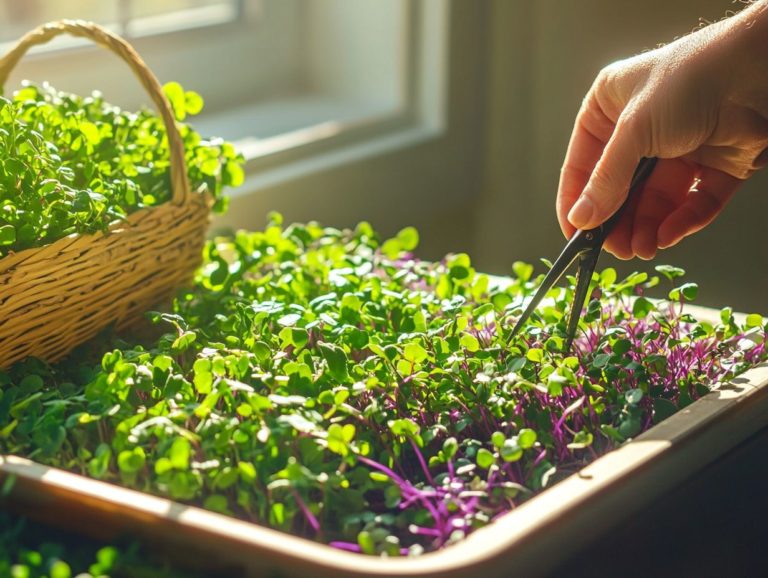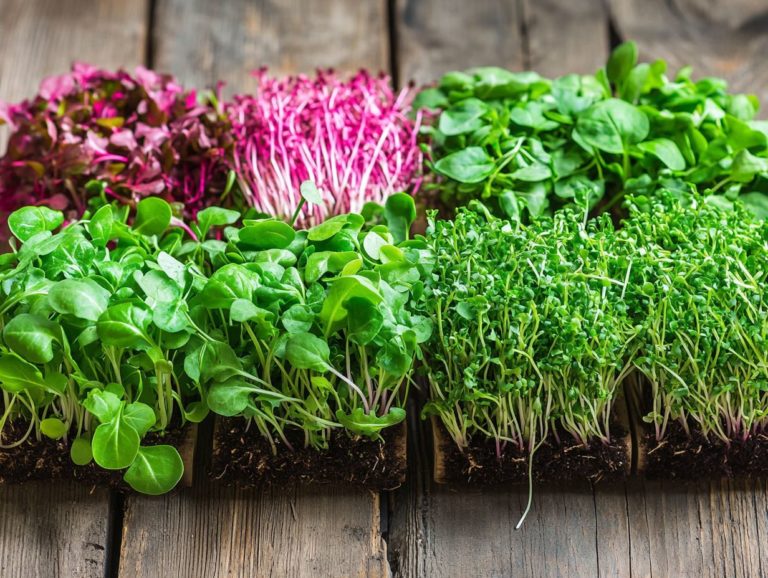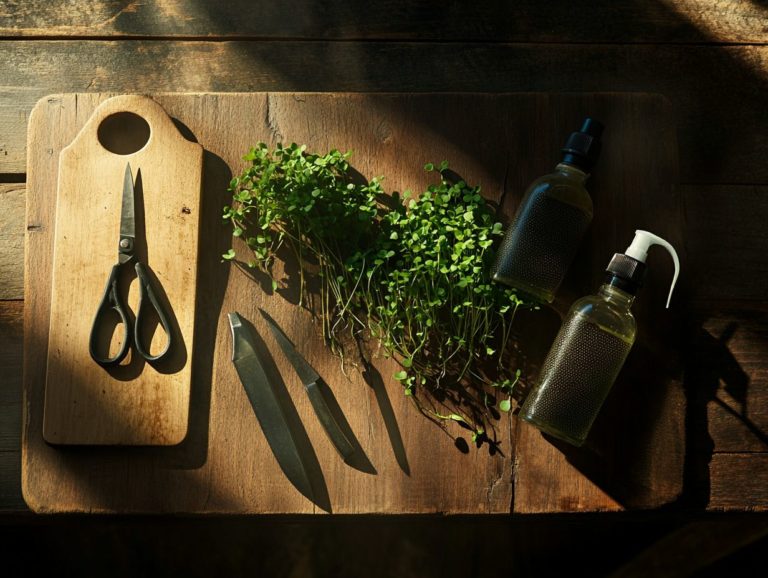How to Keep Microgreens Fresh Longer
Fresh microgreens are not just a culinary delight; they offer an impressive burst of flavor and nutrients that can elevate any dish. Their freshness is key to enhancing both taste and health benefits, making it crucial to store microgreens properly.
This article explores the factors that influence the freshness of microgreens, from storage conditions to harvesting techniques. You’ll discover practical tips for keeping these vibrant greens at their peak and innovative ways to incorporate them into your meals, including storage techniques that enhance their quality.
Get ready to elevate your meals with fresh microgreens!
Contents
- Key Takeaways:
- The Importance of Fresh Microgreens
- Factors That Affect Microgreen Freshness
- Tips for Keeping Microgreens Fresh
- Ways to Extend the Shelf Life of Microgreens
- Frequently Asked Questions
- How do I store microgreens to keep them fresh longer?
- Do I need to wash microgreens before storing them?
- Can I freeze microgreens to keep them fresh longer?
- What is the ideal temperature for storing microgreens?
- How long can I keep microgreens in the refrigerator?
- Are there any containers that are best for storing microgreens?
Key Takeaways:

- Store microgreens in a sealed container with a damp paper towel to maintain moisture and prolong freshness.
- Harvest microgreens at their peak by cutting them just above the soil surface. Avoid washing or refrigerating them until ready to use.
- Preserve microgreens by freezing them in an airtight bag or incorporating them into recipes like salads, sandwiches, and smoothies for added flavor and nutrition.
The Importance of Fresh Microgreens
Fresh microgreens aren’t just a colorful and flavorful touch to your meals; they deliver an impressive nutritional boost as well. Packed with vitamins, minerals, and antioxidants, they can significantly enhance your overall health.
Their nutritional value varies based on several factors, including harvesting and storage methods. Understanding the significance of freshness is essential for maximizing their benefits, ensuring that each bite is bursting with flavor and rich in nutrients.
Why Freshness Matters
The freshness of microgreens directly impacts their nutritional value, flavor, and shelf life. This makes it essential for both consumers and chefs to prioritize quality in their selections.
When you harvest microgreens at their peak, you unlock vibrant flavors and benefit from higher levels of essential vitamins and minerals. To maintain this freshness, it’s crucial to employ proper storage techniques. Additionally, knowing how to water microgreens effectively can further enhance their quality. For example, keeping them in a cool, dark place like your refrigerator can significantly help preserve moisture and flavor.
Using airtight containers minimizes exposure to air, reducing oxidation that often degrades taste and nutrients. By incorporating methods like hydroponic systems, which grow plants in water without soil, or aquaponic systems that combine fish farming with plant cultivation, you ensure these nutrient-packed greens retain their crisp texture and rich taste, ultimately enhancing your culinary experience.
Factors That Affect Microgreen Freshness
Freshness factors are essential in determining the quality and shelf life of microgreens. Consider aspects like moisture balance, air circulation, and storage conditions; these elements can profoundly influence both the longevity and nutritional integrity of your greens.
Prioritizing these details ensures that you enjoy the full benefits of your microgreens for as long as possible.
Storage Conditions
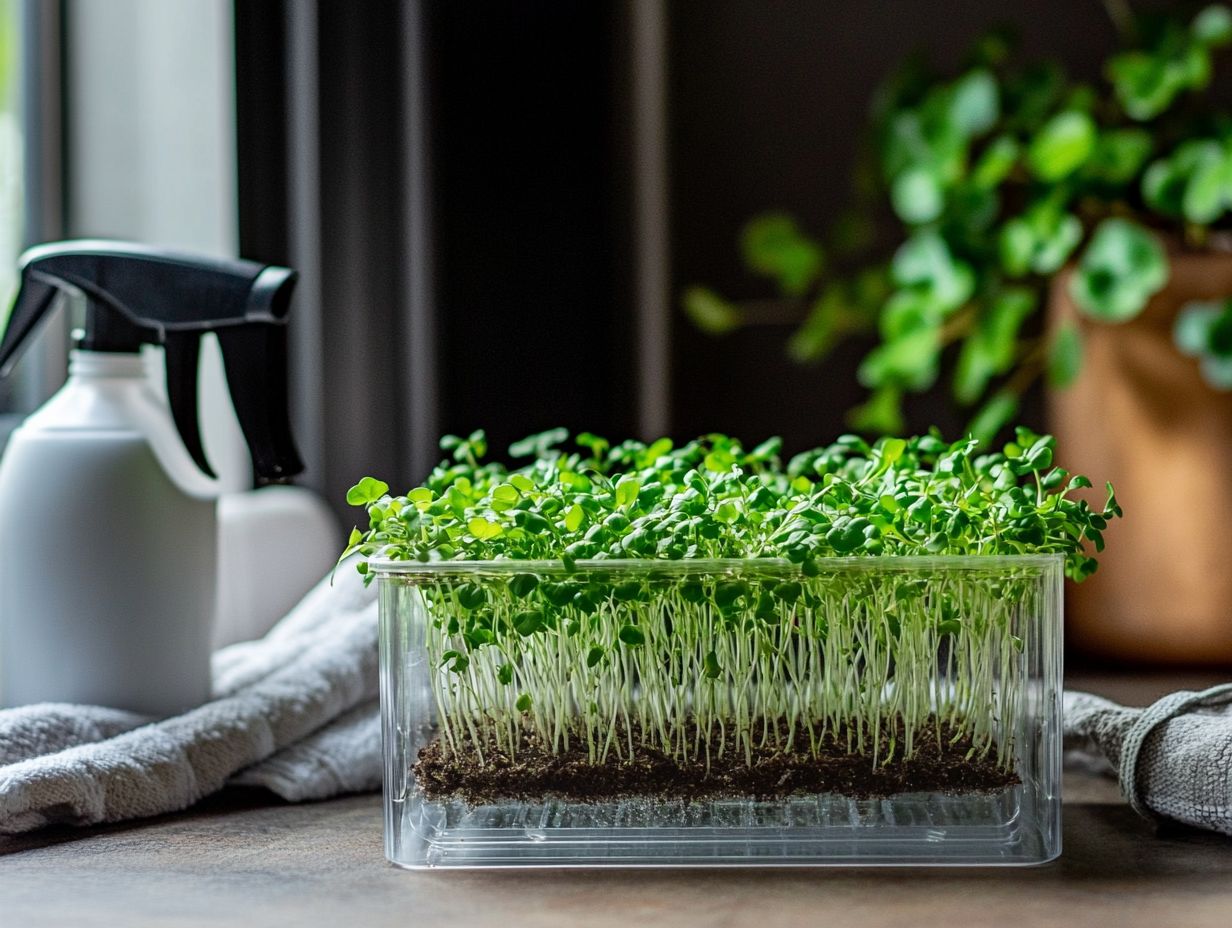
Proper storage conditions are essential for extending the freshness of microgreens. Consider techniques like using airtight containers to minimize condensation and keeping microgreens away from ethylene gas-emitting fruits.
Opting for plastic containers designed for food storage can enhance this process, creating a protective barrier against moisture and airflow. It s crucial to maintain a consistent refrigeration temperature, ideally between 32 F and 34 F, to slow nutrient degradation.
Before using your microgreens, inspect them carefully to ensure you select only the freshest ones, preserving their vibrant flavors and nutritional value.
Start using these strategies today to enjoy a longer shelf life for your microgreens, making them an excellent addition to your meals while minimizing waste.
Harvesting Techniques
Effective harvesting techniques are essential for you, especially when using sharp scissors and practicing gentle handling. These methods are crucial in preserving the delicate structure and moisture content of microgreens.
Timing is everything. You ll want to harvest your microgreens just before they reach maturity to capture their peak flavor and nutrient profile. A clean, sanitized workspace is also non-negotiable it ensures that your greens remain uncontaminated, enhancing their overall quality.
When gathering those microgreens, remember to avoid excessive pressure. Even slight bruising can lead to moisture loss and spoilage, which no one wants. By adopting thoughtful harvesting methods, you can extend the shelf life of these tiny powerhouses and learn how to store different microgreen varieties to deliver a vibrant, nutritious product.
Tips for Keeping Microgreens Fresh
To uphold the quality and flavor of your fresh microgreens, embrace particular tips that emphasize moisture control, improve storage methods, and guarantee proper air circulation.
By paying attention to these details, you can ensure that your microgreens remain vibrant and delicious for as long as possible.
Proper Storage Methods
Using proper storage methods, like placing fresh microgreens in airtight containers and wrapping them securely in plastic, can significantly enhance their shelf life while maintaining moisture balance.
Many growers find success by adding damp paper towels within the containers to regulate humidity, which is crucial for preserving delicate leaves.
Storing microgreens in the refrigerator’s crisper drawer is also effective, as both temperature and humidity are typically ideal for maintaining freshness.
Some enthusiasts recommend using glass jars with breathable lids to allow airflow, preventing wilting while keeping the greens crisp. By employing these diverse storage strategies, you can savor your nutritious microgreens for an extended period.
Optimal Harvesting Practices
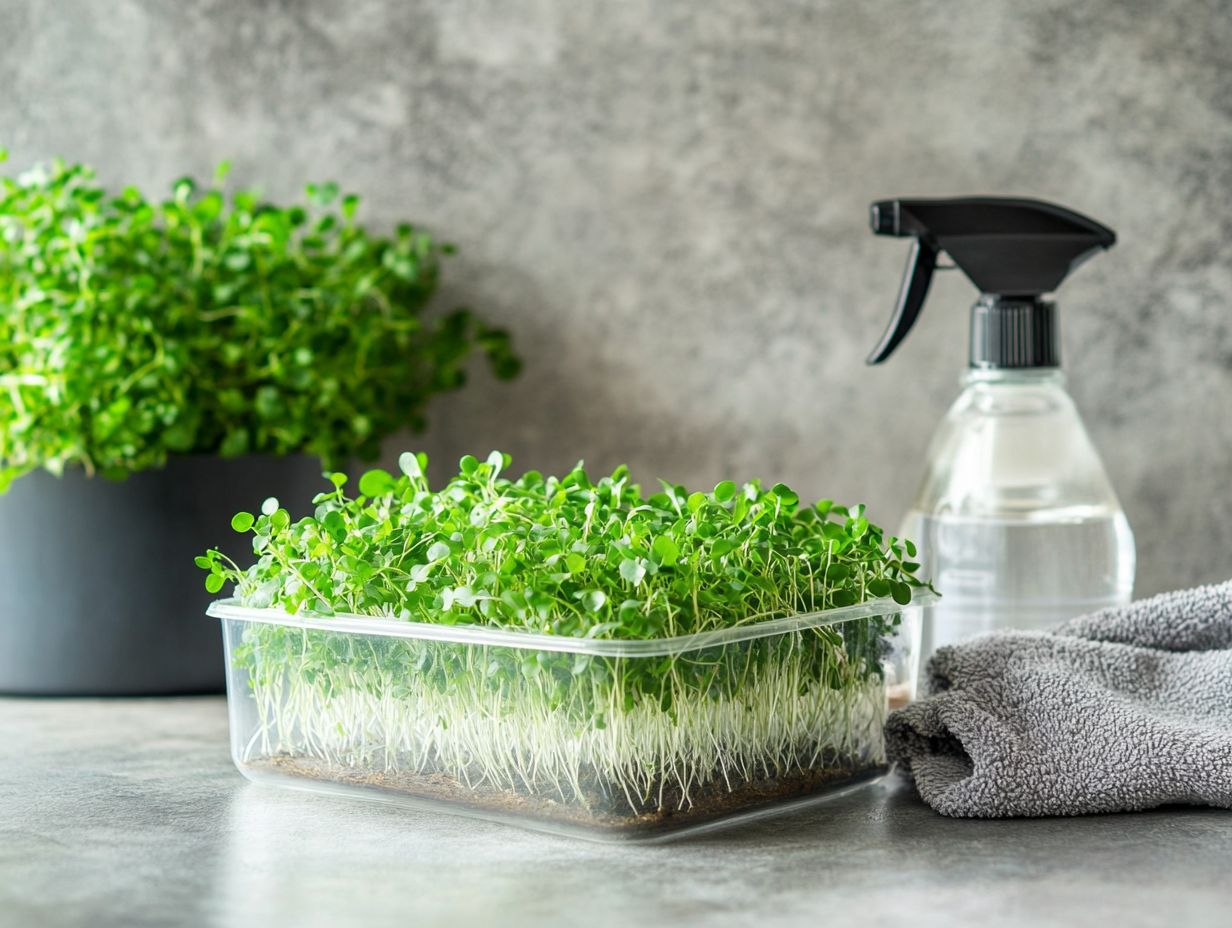
Adopting optimal harvesting practices is crucial for preserving moisture levels and maximizing the quality of your microgreens. Using a sharp knife and handling them gently makes all the difference.
This significantly enhances the flavor profile and nutritional value of your crops. Remember, using clean, sanitized tools protects your greens from contamination and ensures a clean cut, vital for preventing damage to those delicate stems.
Harvesting in the early morning, when moisture levels are at their peak, guarantees that your microgreens will retain their freshness for longer. To learn more about effective techniques, consider checking out how to maximize yields from microgreens. Keep a close eye on your environment to maintain ideal conditions until they reach the consumer or grace the kitchen table.
Ways to Extend the Shelf Life of Microgreens
To extend the shelf life of your fresh microgreens, employ effective preservation techniques that focus on moisture control. This approach helps maintain their nutritional value while ensuring they remain visually appealing and appetizing.
Preservation Techniques
Effective preservation techniques, such as managing moisture content and learning how to store them in the fridge, can significantly enhance the longevity of your microgreens while preserving their nutritional integrity.
By storing your microgreens in a breathable container, you facilitate optimal air circulation, essential in preventing pesky mold growth. Using a paper towel to absorb excess moisture helps regulate humidity, keeping your greens fresh and vibrant. Additionally, employing watering techniques for thriving microgreens can further enhance their growth and health.
Setting your refrigerator at the ideal temperature, between 32 F and 41 F, plays a vital role in extending their lifespan. By following these methods, you preserve their flavor and nutrient density, ensuring they remain a delightful addition to any culinary masterpiece.
Want to keep your microgreens fresh longer? Try these tips today and enjoy fresh, delicious microgreens in every meal!
Using Microgreens in Recipes
Incorporating fresh microgreens into your recipes not only enhances flavor and texture but also amplifies nutritional benefits. They are an exceptional choice for elevating dishes with local produce like radish microgreens and pea shoots.
These petite greens, bursting with vibrant flavors, can elevate salads, sandwiches, and even smoothies. They provide an effortless way to infuse essential vitamins and antioxidants into your meals. For example, sunflower microgreens offer a delightful crunch, while kale microgreens add a subtle earthiness that beautifully complements a variety of entr es.
Chefs and home cooks both appreciate the versatility of these nutrient-rich greens. Whether garnishing gourmet dishes or enriching simple breakfast omelettes, embracing a range of microgreens can transform everyday meals into culinary adventures that nurture your health without compromising on taste!
Frequently Asked Questions
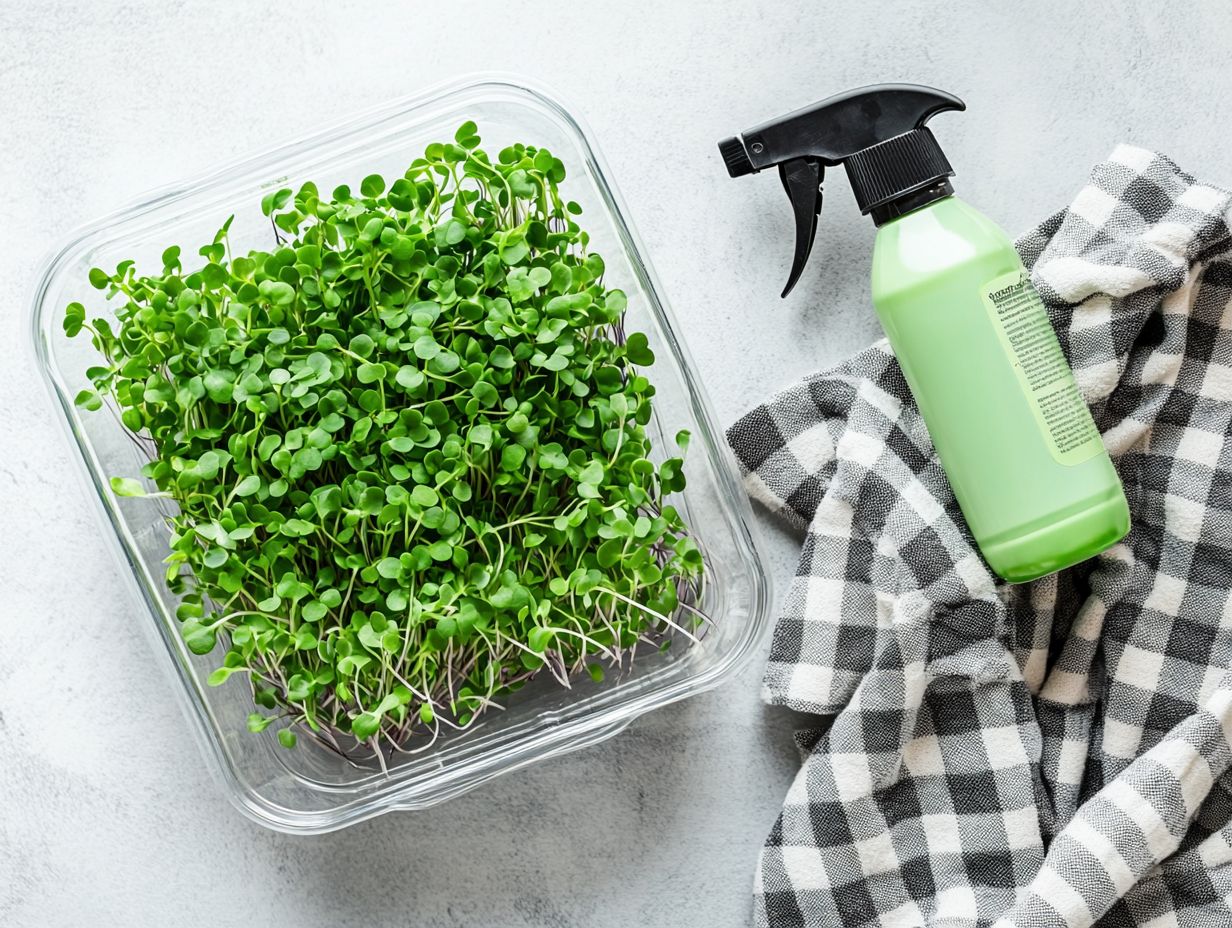
How do I store microgreens to keep them fresh longer?
The best way to store microgreens is in an airtight container in the refrigerator. Techniques such as reducing moisture and using a paper towel to absorb excess moisture can help keep microgreens fresh.
Do I need to wash microgreens before storing them?
It’s best to wash microgreens right before consuming them, as excess moisture can cause them to spoil faster. If you need to wash them before storing, make sure to thoroughly dry them by reducing moisture before placing them in a plastic container.
Can I freeze microgreens to keep them fresh longer?
While it is possible to freeze microgreens, it can affect their texture and flavor, which might impact their nutritional value. For the best taste and nutritional benefits, it’s best to consume them fresh.
What is the ideal temperature for storing microgreens?
Microgreens should be stored at a temperature between 36-40 degrees Fahrenheit, which is ideal for preserving nutrients. Avoid storing them in the door of the fridge, as the temperature fluctuates more there.
How long can I keep microgreens in the refrigerator?
With proper storage, microgreens can last up to 7-10 days in the refrigerator. Factors affecting their shelf life include moisture levels and temperature. Always check for any signs of spoilage before consuming them.
Are there any containers that are best for storing microgreens?
Glass or Lock & Lock plastic containers with a lid are ideal for storing microgreens. Ensure the container is large enough to accommodate the greens without crushing them, and the lid should create an airtight seal to maintain proper moisture balance.
Try incorporating microgreens into your recipes today for a fresh take on your meals!


